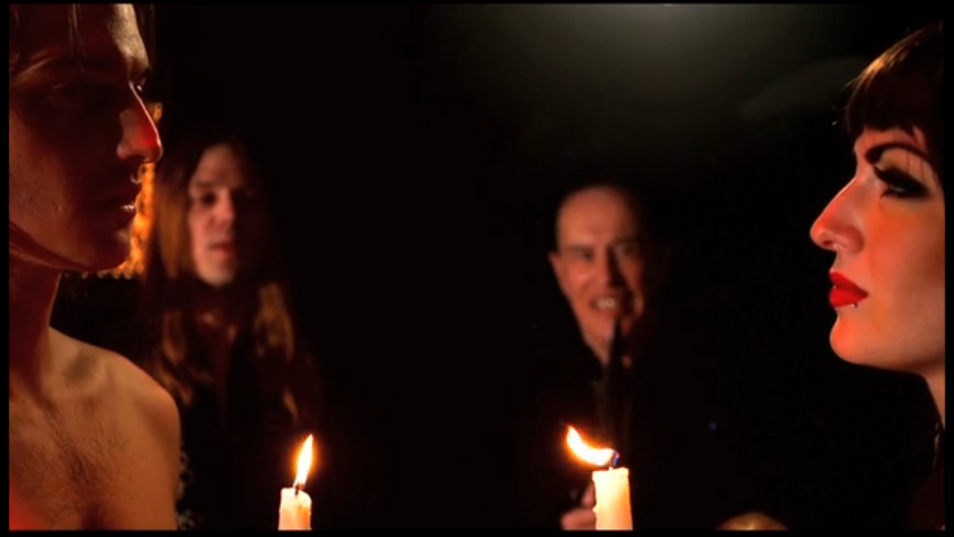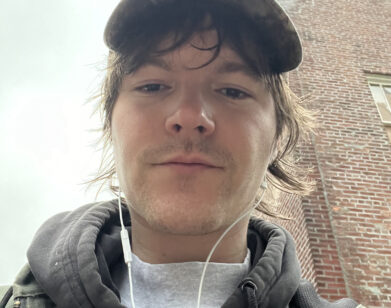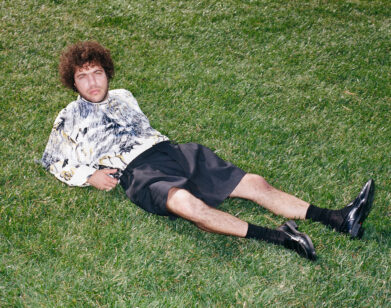Exclusive Video Premiere and Interview: ‘Love in the Old Days (Ted James 1999 Remix),’ Daddy

When James Franco started film school, at NYU, he dedicated his first short film to Kenneth Anger: the iconoclastic, tremendously influential director of such early experimental films as Scorpio Rising and Inauguration of the Pleasure Dome, whom Franco had never met.
It’s been several years since then, and among Franco’s myriad projects these days is a musical duo called Daddy, formed with artist/musician Tim O’Keefe, whom Franco met at RISD. When it came time to direct a video for a remix by producer Ted James of one of Daddy’s songs, “Love in the Old Days,” Franco had the rare opportunity to cast one of his idols. Anger stars in the video as an occult priest, playing a theremin while officiating what Franco calls “the marriage of Hell” in a strip club.
We’re very pleased to premiere “Love in the Old Days (Ted James 1999 Remix)” here; read on for our interview with Franco about the video and Anger’s influence.
ALEXANDRIA SYMONDS: How did Kenneth Anger react when you approached him with this concept? Or was it more collaborative—did you come up with the idea together?
JAMES FRANCO: This is the first time I’ve worked with Kenneth. But I’ve been very influenced by his work before this. I met one of his close collaborators, a guy named Brian Butler, and Brian and I have been talking about various projects for a while, and we just haven’t been able to do any of them yet. Brian has a movie that he wants to direct, and he wants me to be a little part in. And then when I learned that he did a lot of stuff with Kenneth, I couldn’t have been more excited.
So Brian set up the meeting, and Kenneth is a—[laughs]. He’s a nice guy, but I think he’ll admit, he’s a very strange guy. So the conversation was very weird. We met at the Chateau Marmont, Brian was there. I’d have this whole conversation with Brian, because Kenneth was really quiet, and I’d ask Kenneth something, and it was like he wasn’t even listening—but then, he’d kind of become aware. And he’s very smart, he’s been through so many different kinds of experiences, and was a part of so many different things, traveling with the Rolling Stones at the end of the ’60s. So at times, if you can get him to talk, he’s very knowledgeable and informative. But at other times, it feels like he’s just thinking about other things.
SYMONDS: What about on the set? What was it like to direct him? Did you basically just let him do his thing?
FRANCO: Right. So, I read this book called Sway, that’s a fictional novel, but it uses Kenneth and the Rolling Stones, and this guy, Bobby Beausoleil, who was part of Manson’s group, as characters. I don’t know how true any of it is, but I’m sure the writer did research to make a lot of it at least based on fact. In that book, he has the character of Kenneth Anger making the films—the films that Kenneth actually made. And there were certain approaches that he had to these films, where he would shoot a lot of things kind of documentary-style, just people doing their regular routines. Or sometimes, he would stage these basic rituals, but in the editing, turn them into something much more energetic and artistic than they were when they were just filmed.
I guess I used whatever was in that book as kind of a guide about how to work with him. All I really needed was this basic ritual of, I guess you would call it, “The Marriage of Hell.” And we had imagery that was people in animal masks, that was based on certain images that Kenneth’s friend Brian had shown me. I always saw Kenneth as the Priest of Darkness; his films have strangely fused art and weird, kind of religious rituals. And I knew in one of his performances he plays that weird instrument called the theremin. So, if I just had him kind of preside over the wedding and play the theremin, I knew I could shoot it similarly to the way he shot his movies, and then edit it, and make it into something even more.

SYMONDS: The occult is obviously pretty strongly associated with his work, and in this video, too. So I’m curious: Do you think the occult, generally, is more mainstream now than it was in the early ’60s when he was experimenting with it?
FRANCO: I really am just viewing that kind of stuff through an aesthetic lens—it’s not something that is brought into my everyday life. It’s not like whatever is depicted spills over into my religious practices or anything like that. [laughs] It’s purely aesthetic, and I feel like that—I’m not positive about this, but I feel like that’s kind of what Kenneth did, as well. If you look at his various projects, he would use things like the occult or even celebrity and celebrity gossip, but he would transform these things into something new, so that they were used for their aesthetic properties. When you watch his films, it’s almost like they’re half films and they’re half just experiences. That’s really how I view the imagery and the ritual in my thing, purely for artistic purposes. As far as people that actually practice those kinds of things in life, I really don’t know that much about it. [laughs]
SYMONDS: I was actually more asking on an aesthetic level—like, when you have Ke$ha making a video with Illuminati imagery in it. A ton of pop stars, now, are into bringing in these trappings of the occult.
FRANCO: You know what? I fully believe that that is one of Kenneth Anger’s legacies. Some people will even say Kenneth Anger was doing early forms of music video. Now, I feel like that minimizes what he was doing with his films, but you can see that a lot of the techniques—Scorpio Rising, for example, the way he mixes all the pop hits of the day with these images that are very jarring with that music. These bikers and all this very dark imagery with very kind of poppy beach kind of music. That was so fresh. I think even Scorsese cites it as a huge influence for the way that he started using music in his films—the way he would put The Rolling Stones into Mean Streets and the way he still does it in his films.
In that same way, what you’re talking about with the way that certain kinds of imagery are used in music, or even in something like Spring Breakers, the way that pop culture is now fused with images from other spheres, is, I think, very today. It’s sort of calling attention to the way that technology, pop culture, the Information Age, social networks—how all of this has become kind of the center. And because of that, it’s now fused with religious iconography, with things like that—in some ways, it does have as much power as religion.
SYMONDS: A few years ago, we had Gaspar Noé interview Kenneth. I wanted to ask you something Gaspar asked Kenneth: “What is the essence of cinema for you? Is it reproducing the language of dreams, or creating a shamanistic trance?”
FRANCO: Right. Well, that’s a great question. I guess that’s kind of what I was trying to get at. [laughs] I don’t think with the films that I make, I’m trying to entrance anybody. I respect films that give an experience: that aren’t telling a story that could be told in another medium just as well, but that are using all the techniques of film, as far as the way that it’s shot, and the way that it’s edited, and the soundscape. To use Spring Breakers again, I feel like when people watch that, they’re not watching just for the story, or the movie itself is not dependent solely on the narrative or the narrative arc. What is driving that film, and what people are engaged with, is much more experiential and an experience that could only be given through the film form. I don’t know if I’d say that that’s what I believe all films should do; but the films that do that, I respect a lot.
DADDY’S MOTORCITY AND LOVE IN THE OLD DAYS (THE PVD REMIXES) EPS ARE BOTH AVAILABLE NOW. FOR MORE ON THE DUO, VISIT THEIR FACEBOOK PAGE.






